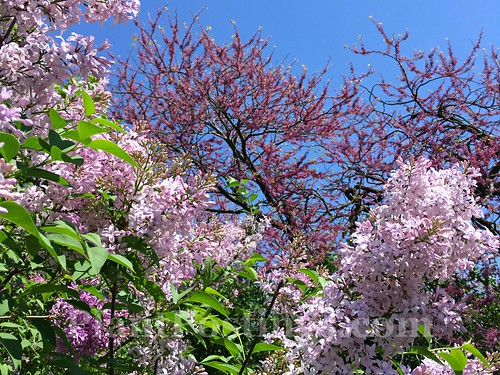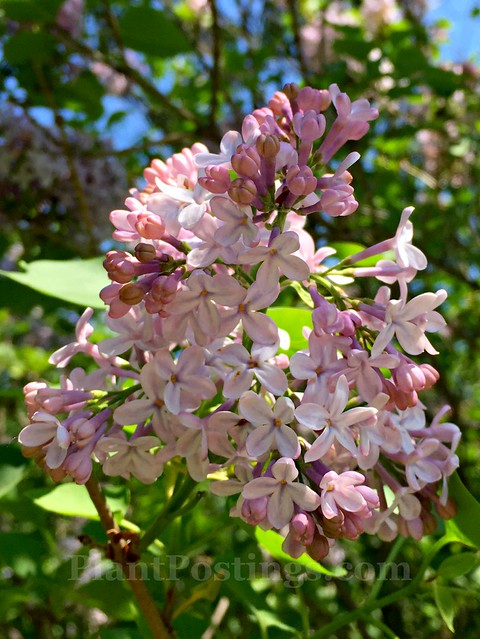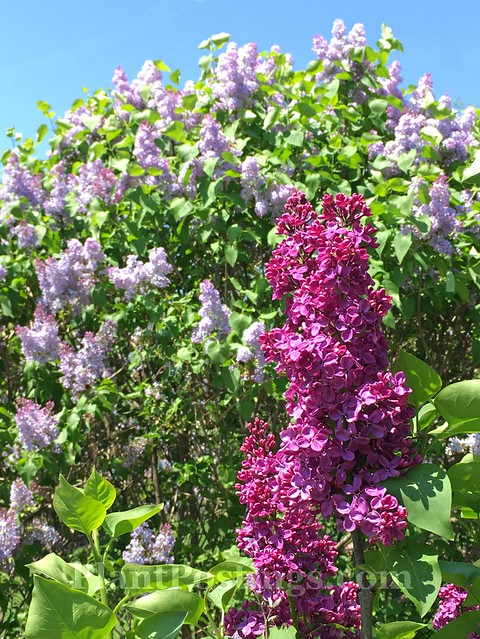
The Garden Bloggers Fling in Austin was full of fun, forbs, and friends. Bloggers from the U.S., Canada, and the U.K. gathered for the annual event in early May.
This was my third Fling, so I'm a relative newbie, although I knew what to expect from the busy pace of touring public and private gardens with fellow plant-lovers.
I also made a few discoveries (and rediscoveries), including:
1. Austin is green. I mean, in the sense that it is lush and full of green foliage and many beautiful trees. I expected it to be drier and closer to a desert-edge type of landscape. I was told that things get dry during the hot summer, but the landscape was certainly verdant in early May.
2. Mobile smartphones take decent photos. This is particularly useful during a rainstorm. Our first full day, Austin received several inches of rain and many of us tucked away our cameras and defaulted to smartphones for photography. Also, at the first event near the downtown library, all I had with me was my smartphone. The photos--both landscapes and semi-macros--turned out better than I expected: not frame-worthy, but fine for online posting.
 |
| View from the top of the Austin Central Library |
 |
| Another scene looking out from the libraray |
 |
| Pineapple Guava flower (Acca sellowiana) in the rain |
3. Poppies like Austin. I realize they're common in many gardens around the world, but they were prevalent and thriving in most of the Austin gardens we toured. The blooms and the seedheads offered color and structural interest--often in unexpected places. They spoke to me.



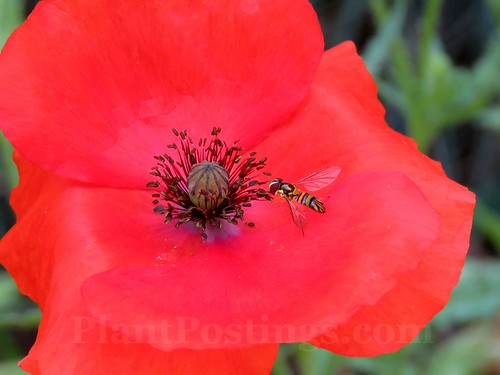


4. A fault line runs down the middle of Austin. To the west, gardeners must deal with limestone outcroppings, often with very little soil on top. To the east, the soil tends to be clay-loam, so a little easier for gardening, although the high pH can make it challenging for growing acid-loving plants.
 |
| Balcones Fault at the Zilker Botanical Garden |
5. Austin borders the Hill Country, hence some of the views from Austin-area gardens are spectacular.
 |
| View from the Kirk Walden garden |
 |
| View from the Mirador garden |
6. Austin feels familiar and comfortable. I can't really explain why. Some people say Austin has a similar vibe to Madison but on a bigger scale. I guess that's true, but it's more than that. Austin is friendly and fun and easy to explore. I perceived it to be like a cross between Madison, New Orleans, and San Diego. Well, that's really simplifying it without really explaining it--Austin has its own vibe. But it feels comfortable.
 |
| View from the Ruthie Burrus garden |
7. Stock tanks are great gardening vessels. Not much more to say about that. They were everywhere, and used in some pretty creative ways.
 |
| Plant displays at the Lady Bird Johnson Wildflower Center |
 |
| Pam Penick's creative stock tank pond and sunburst patio |
 |
| Jenny Stocker's nifty pond/rain garden |
 |
| Another creative Jenny Stocker pond |
8. Praying mantis babies are cute, and they move fast! At Jenny Stocker's garden some mantises hatched in front of our eyes. Jenny patiently held the egg case and the mantises while we photographed the event.
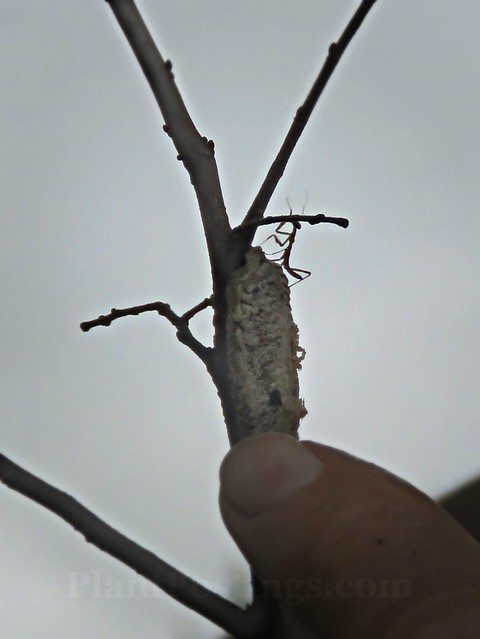
9. Blue rocks and marbles create a sense of water and hydration. I mean, I guess I knew this, but it was great to see it in practice in several gardens.
 |
| Blue rocks being "poured" at the Colleen Jamison garden |
 |
| Blue marbles in a "pool" of succulents; also at the Colleen Jamison garden |
 |
| Blue rock flowing through tiles at B. Jane Gardens |
 |
| Blue rock in pot echoing blue rock mulch; also at B. Jane Gardens |
10. Austin gardeners know how to do rain gardens, ponds, and other water-management features. They were beautiful, functional, and structurally interesting.
 |
| Rain garden with various rock sizes at Jenny Stocker's garden |
 |
| Rain drain system at the Mirador garden |
 |
| Modern pond feature at the Mirador garden |
 |
| Rain garden at the Kirk Walden garden |
 |
| Rain garden with fountain at the Colleen Jamison garden |
11. Roses framed by Bamboo; who knew? This combination caught me by surprise at the B. Jane Gardens. It was lovely.

12. Broken dinnerware creates colorful garden flair. Lucinda Hutson's magical garden was chock full of fun, but the plates as decorations provided particular inspiration.
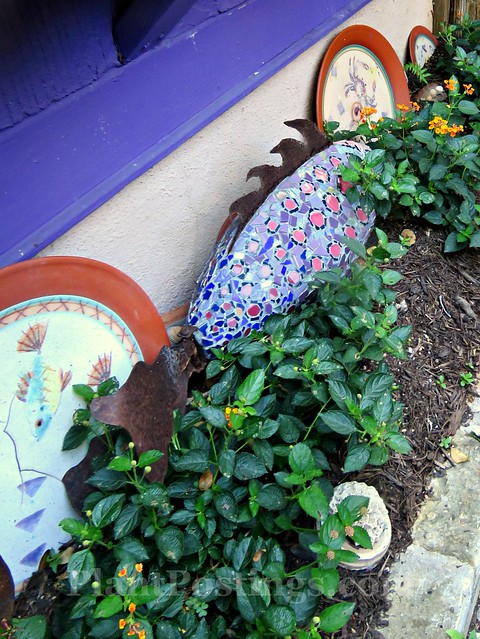


13. Wine corks as mulch--great idea! Another fun touch at Lucinda's garden. I really like this idea, and I hope to incorporate it somewhere.
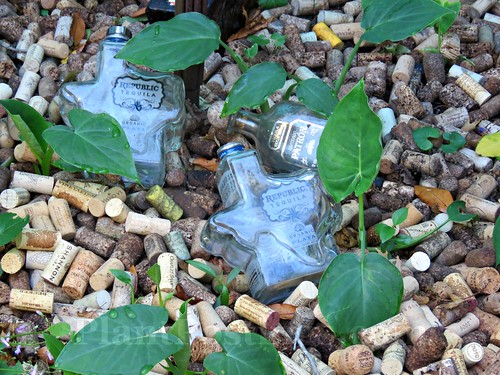
14. 'Magenta Spreen' Lambsquarter (
Chenopodium giganteum) functions as a delightful ornamental in pots; plus it's edible. Lucinda incorporated many edibles in pots--they looked lovely and tasty. I realized this would be a fun plant to try as an alternative to coleus and other colorful foliage.

15. Loquats are tasty, but don't eat the seeds. Somewhere during our tour, we ran across a huge Loquat tree and were able to sample the fruit. I'd never tasted it before. It was sweet and delicious; I don't know how to describe it. But I was told to spit out the seeds, and later learned they contain toxins that release cyanide when digested.

And there's so much more to say and show, but too much for one post. This was a very fun Fling! I'm sure I'll have more posts about it in the future. For more coverage, check out fellow bloggers' posts at the official
Fling website. Thanks to the planners: Pam, Diana, Laura, Sheryl, and Jennifer; and to all the friendly, welcoming Austin bloggers and gardeners!
